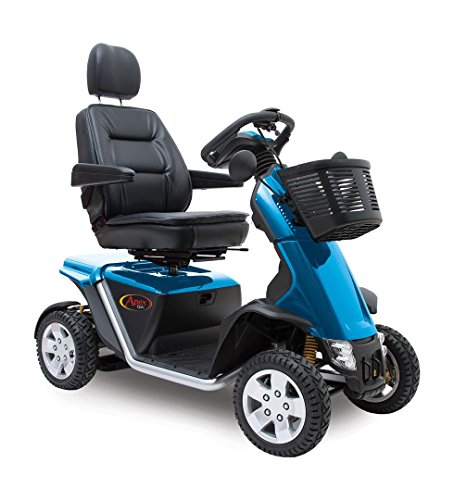Mobility scooters have revolutionized the way people with limited mobility navigate their day-to-day lives. In the UK, these devices are becoming increasingly popular as they offer independence, freedom, and a renewed sense of confidence for individuals with mobility challenges. Whether you're exploring mobility scooters for yourself or a loved one, this comprehensive guide will walk you through everything you need to know, from their types and benefits to legal requirements and helpful FAQs.
What is a Mobility Scooter?
A mobility scooter is a motorized device designed to assist individuals who have difficulty walking or navigating long distances. Combining technology with ergonomic design, these scooters provide a safe, convenient, and comfortable means of transportation. They are especially beneficial for seniors, people recovering from injuries, or those with disabilities that affect walking.
Types of Mobility Scooters Available in the UK
Mobility scooters vary in size, design, and functionality. Here are the main types:
1. Compact/Portable Mobility Scooters
- Designed for short trips and easy storage.
- Can be folded or disassembled for transport.
- Ideal for indoor use and flat terrain.
2. Medium-Sized Mobility Scooters
- More versatile than compact models.
- Offer better battery life and speed.
- Suitable for a mix of indoor and outdoor use.
3. Large/Heavy-Duty Mobility Scooters
- Built for outdoor travel and rough terrain.
- Feature increased weight capacity, speed, and stability.
- Equipped with advanced suspension and comfort features.
4. Class 2 and Class 3 Scooters (specific to the UK)
- Class 2 Scooters: Designed for pavement-only travel with a speed limit of 4 mph. These are lightweight and easy to maneuver in tight spaces.
- Class 3 Scooters: Approved for road use, featuring a higher speed limit of up to 8 mph. These often come with indicators, headlights, and rearview mirrors.
Benefits of Mobility Scooters
1. Enhanced Independence
Individuals no longer have to rely on others for transportation. Mobility scooters empower users to complete errands, visit friends, or explore parks independently.
2. Accessibility
Many mobility scooters are designed to access narrow pathways, pedestrian areas, and even indoor spaces like shops and malls.
3. Cost-Effective and Energy Efficient
Compared to owning and operating a car, mobility scooters are relatively inexpensive to maintain and run, using rechargeable batteries for power.
4. Comfort and Safety
Features like padded seats, adjustable tillers, anti-tip wheels, and safety lights combine to ensure a smooth and secure ride.
Things to Consider When Buying a Mobility Scooter
Shopping for a mobility scooter involves careful consideration to find the perfect fit. Here are some factors to keep in mind:
User Needs
- What will it primarily be used for (short errands, long-distance travel, etc.)?
- Does the individual require additional safety features?
Size and Portability
- Consider available storage space and whether you need a model that folds or disassembles for easy transport.
Weight Capacity
- Check the maximum weight the scooter can support to ensure safety and efficiency.
Budget
- Mobility scooters range from a few hundred pounds for basic models to several thousand pounds for high-end, feature-rich scooters. Look for models that balance cost and utility.
Comfort and Adjustability

- Assess seat size, adjustability of the handlebars/tillers, and overall ergonomics.
Battery Life and Charging
- Ensure the scooter’s battery can accommodate the distances typically traveled between charges.
Legal Aspects of Using Mobility Scooters in the UK
In the UK, mobility scooters are categorized as Class 2 or Class 3 vehicles. Understanding the legal framework around these devices is crucial for safe and lawful use.
- Registration: Class 3 scooters must be registered with the DVLA. Class 2 scooters do not require registration.
- Insurance: While not legally mandatory, insurance is highly recommended to cover potential damage, theft, or accidents.
- Speed Limits: Class 2 scooters have a speed limit of 4 mph. Class 3 scooters can travel up to 8 mph on roads and 4 mph on pavements.
- Licensing and Age Restrictions: Users do not need a driving licence, but they must be over the age of 14 to operate a Class 3 scooter.
- Etiquette and Safety: Users should exercise caution on pavements, respecting pedestrians and maintaining speed within the legal limit.
Top Brands of Mobility Scooters in the UK
Several trusted companies design and manufacture mobility scooters in the UK. Some of the top brands include:
- Pride Mobility: Renowned for innovative designs and user-friendly features.
- Drive DeVilbiss: Known for dependable and versatile scooters.
- TGA Mobility: Offers premium, high-performance scooters with advanced features.
- Invacare: Specializes in ergonomic designs to enhance comfort and ease of use.
- Kymco Healthcare: Focuses on durability, advanced features, and excellent mobility solutions.
Maintenance Tips for Mobility Scooters
To ensure the longevity of your mobility scooter, regular maintenance is essential. Follow these tips:
- Check Tires: Look for wear and tear and ensure proper inflation for pneumatic tires.
- Battery Care: Charge the battery regularly and avoid overcharging to extend battery life.
- Inspect Brakes and Controls: Periodically test brakes, lights, and steering mechanisms for proper functionality.
- Clean Regularly: Keep your scooter clean to avoid dirt or debris impacting its performance.
FAQs About Mobility Scooters in the UK
1. Do you need a licence to drive a mobility scooter in the UK?
No, a licence is not required. However, Class 3 scooter users must be at least 14 years old and follow road regulations.
2. Can mobility scooters be used on public transport?
Yes, many buses, trains, and taxis accommodate mobility scooters, but it’s a good idea to check with the service provider beforehand.
3. Are there government grants available for mobility scooters?
Yes, financial assistance may be available through the UK’s Motability scheme or local council grants for individuals with eligible disabilities.
4. What is the lifespan of a mobility scooter battery?
Most batteries last 12 to 18 months, depending on usage and proper maintenance.
5. Can I take my mobility scooter abroad?
Many scooters are airline-approved for international travel, but it’s essential to verify specifications and regulations with the airline.
Final Thoughts
Mobility scooters are an invaluable resource for enhancing independence and improving quality of life for individuals with mobility challenges. With numerous models, features, and price points available in the UK, there’s a mobility scooter to suit every need. When selecting a scooter, consider the user’s requirements, safety features, and budget alongside the legal guidelines specific to the UK.
Investing in the right mobility scooter can restore confidence, providing a newfound sense of freedom and the ability to explore the world without limitations. If you’re in the market for a mobility scooter, start by identifying your needs and consulting with reputable suppliers to ensure the best possible choice.
Remember: With proper care, a mobility scooter can be a lasting companion that transforms journeys into enjoyable, stress-free experiences.








